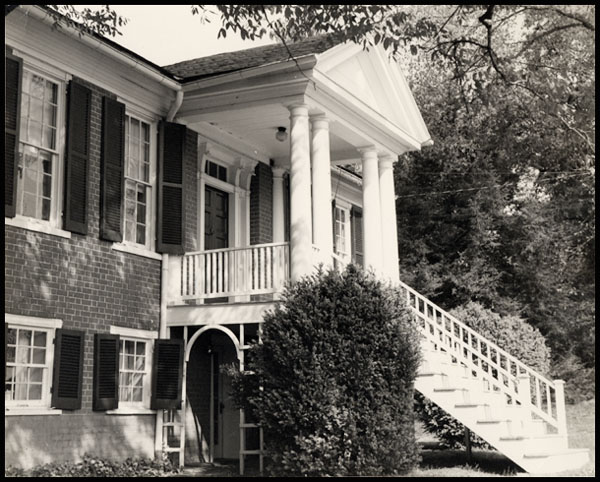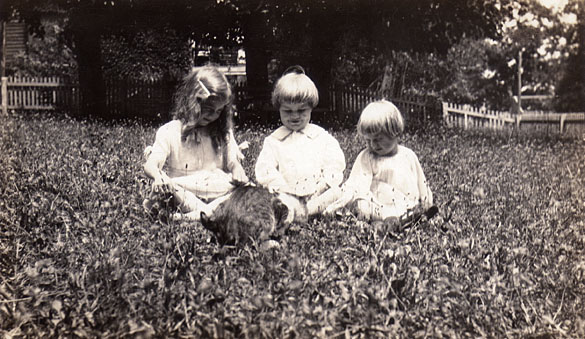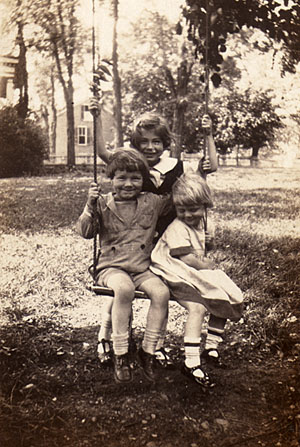

  |
|

|
Name: The Jefferies-Bruce House Date: ca. 1969 Image Number: B252cdB25 Comments: The Jefferies-Bruce house, located at 540 Harrison Street, is an excellent example of 19th century symmetry in design and craftsmanship with its Tuscan portico, four matching chimneys, and double-pile central passage floor plan over a high basement. This house was built ca. 1838 on land, which was at one time part of Belle Grove Plantation and is now part of the Harrison Addition in Scottsville. After the Civil War, Virginius Bronaugh Jefferies and his wife, Anna (Lewis) Jefferies raised their two children, Margaret and Elizabeth, in this home. Virginius served in the Confederate Army as a Sergeant in the 3rd Regiment, Virginia Cavalry, and after the war, he returned to Scottsville where he worked as the town druggist. Virginius and his brother, Dr. James M. Jefferies, who served as the Chief Surgeon at the Scottsville Confederate Hospital during the Civil War, were much beloved in Scottsville. After their father passed away, Margaret and Elizabeth Jefferies continued to live in the Jefferies home. On December 15, 1919, Thomas Ellison Bruce purchased this home and three lots from Elizabeth Jefferies (Albemarle Co. Deed Book 172, pp. 72-73). Ellison also was a druggist, and it seemed fitting that this home would be eventually named after both druggists who lived here. The Bruces raised three children in this home: Rebecca Jane, Thomas E., and Anne Shirley Bruce. Ellison was a popular and successful businessman and also served as Mayor of Scottsville for four terms between 1935 - 1943. Shown below is the Jefferies-Bruce home in 2010:
To Shirley Dorrier, who was born and grew up there, it's always been "the rectangle house." An 1893 Scottsville brochure notes its "good lines and great dignity." Known traditionally as the Jefferies-Bruce House, Virginia Moore calls it one of Scottsville's "treasures." "An excellent period example of symmetry in design and craftsmanship," wrote students of UVA Professor K. Edward Lay in their 1990 Studies in Vernacular Architecture, No. 97. It's 540 Harrison Street, part of Scottsville's Historic District, now being preserved by owner, Jeffrey Plank, who is Chairman of Scottsville's Architecture Review Board. Harrison Street, parallel to and west of Valley Street on higher, tree-shaded ground, was once part of Belle Grove plantation, first owned by Scottsville's founder, John Scott. Later owner Peyton Harrison, grand-nephew of Declaration of Independence signer, Benjamin Harrison, laid out a number of lots, and in 1830, they were appended to the Town of Scottsville as the Harrison Addition. Harrison Street was put in that year or the next. The 1830's were the heyday of business and building activity on the Horseshoe Bend, and the grand houses along Harrison Street are, Jeffrey Plank thinks, "a remarkable document of the level of sophistication to which Scottsville aspired." But real estate speculation, death, mortgage defaults, and other entanglements moved some of the Harrison Street lots through the hands of several owners. Lot Nos. 172, 173, and 174 in the middle of Harrison Street were sold to "prominent businessman" John B. Hart in 1837. In 1838, Albemarle County records show these lots owned by John Blair, and in 1840 they are in possession of the Blair brothers. It is not clear who built the house, or precisely when. It may have been Hart, as a "speculative business venture," as Alice Bojanowaski and other UVA undergraduates who studied it under the direction of Professor Lay, suggest. 1838 is the best guess, as that is when it first shows up on the county tax records, and this assumption accords with the building's siting and architectural details. The architect recently as been identified by author, Bryan Green, as Thomas Blackburn, "one of Thomas Jefferson's favorite workmen on the UVA project, a talented craftsman whom Jefferson trained, even considered a protege," according to Plank. Blackburn designed the former Western State Lunatic Asylum in 1828 and the Augusta County Courthouse in Staunton, now demolished. Blackburn, who borrowed and copied out Jefferson's precious architecture books, had superb carpentry skills and was familiar with top quality brickwork, facts that link these projects. There is some possibility that he built the home for later owner, John Blair, as it is known that Hart never lived there. In 1863, James Jefferies bought the land and house. Jefferies, Virginia Moore tells us, was a first cousin of Civil War cavalryman, John Mosby, and because chief surgeon at the Scottsville Hospital after the battle of Manassas. In 1869, James sold the package to his brother, Virginius, who ran the Scottsville drugstore, and a period of calm after the earlier court cases settled on the property. The Jefferies family finally sold it in December 1919 to T.E. Bruce, Shirley's father, who had come to Scottsville to operate the drugstore. Bruce married Mary Browne, a teacher in the old Scottsville schoolhouse on the hill, and from 1915-1919 they lived in the cottage at Belle Haven, the Bruces and Pitts families being friends from church. W.D. Smith, later the principal of the high school, was living in the Jefferies house when the Bruces purchased it, and they stayed there about six months, Shirley says. Shirley was born "in the back bedroom" of this house in 1920. Her family lived there until Jeffrey Plank purchased the house in December 1993. Shirley has a sister, Jane, and a brother, Tom, who - like their father - became mayor of Scottsville. Shirley was a teacher at St. Anne's Belfield and during some of the World War II years returned to live at the house. She says there was a cook "most of the time," who lived in an outbuilding on the back lawn, and a gardener, Leslie Lucas, whose work was shared with the C.R. Dorriers. The picket fence, surrounding the house while Shirley was growing up, was gone when the UVA students observed it. "The builder would have no problem recognizing this house today as he walked down Harrison Street...The distinctive Tuscan portico and Greek Revival entry are the same, as is the fine Flemish Bond brickwork (alternating long and short sides of the brick showing in alternating rows), the ...windows, and shutters."  Jane, Tom, and Ann Shirley Bruce in their back yard, 1923. But some additions and changes had been made. The original shingle roof became slate, and Shirley's parents, she says, added back steps from the second floor porch onto the lawn and garden in the rear; these were for the children's use.  Tom, Jane, and Ann Shirley Bruce swinging in the rear garden are their backyard, 1925. Mrs. Bruce followed the plan of Charlottesville gardener and landscape designer, Mrs. Haugh, and terraced the rear lawn into three levels. This provided an area for a vegetable garden along the Lindsay Street frontage, then a baseball and games area, separated from the house by a flower-covered fence, and finally near Clements Street to the north, a tennis court. The chicken coop was also on this level, as well as the garage. Mrs. Haugh had them remove the steps. This was the first tennis court in Scottsville, and Shirley remembers that its grass and limed lines were well used. Her yard was the largest in the neighborhood and "we gathered all the time" on the bottom porch or lawn, playing baseball or round cap, having watermelon parties, or "always" in summer, croquet. A group would make ice cream in a big freezer outside, the little girls dressed in hats, white dresses, and in the 1920s, long white socks with Mary Jane shoes. There was often music. Shirley's mother, Mary, was organist for her church and taught music lessons. The family "always had a piano," and Mary led the singing, though father Tom preferred the Saturday opera on the radio. Shirley eventually took violin lessons in Charlottesville with a group of children including L. Gordon (Chick) Dorrier, her future husband. Most memorable, in the summers, was the excellent harmonica playing of Chick's cousin, Jack Pitts, who visited each year from New York and would play on the porch. In the gang of neighborhood children were Jacqueline Grove from Old Hall, various Dorriers and Pittses, Milton Cohen, Nelson Moon, and Jamie Hill, who lived in Richmond and spent his summers on Harrison Street. Jamie and the cook's son, Garnett Barnett, were the leaders of round cap and other games -- "whatever they told us to play," Shirley says. There were two homes of the Paulett family nearby, and Shirley was "nursemaid" to Ann Paulett. Tyler Goodwin, whose family lived at Shadows, to the south, was older and noted for his visits home. In the 1930s, a "Tom Thumb wedding" was organized by some adults. Old photos are left to document Tom Bruce dressed as a little groom, Shirley as a bridesmaid, and Jimmy Hall as the minister, all complete with fancy costumes. The C.R. Dorriers owned a pony cart, and sometimes Shirley would be picked up, she recalls, for a drive around town; some of the children would ride ponies bareback. Shirley was taught to swim, and her father bought an Old Town canoe for the siblings to use on the James. The family vacationed in Virginia Beach each year. Shirley remembers, in autumn, walking down Lindsay Street, which they called Buttercup Lane, and across Page Street to the small school, burned down in 1980, on the site of the current Scottsville Library. There were pumpkin carving on the porch steps as the weather grew colder, and Halloween costumes and sledding on the hills in winter. Shirley was not often allowed downtown, though her father worked there; there was no "hanging around," she says. Going to the grocery store on an errand became a sought-after privilege, as she enjoyed going out and seeing people. Relatives visited from Charlottesville, and Shirley's mother entertained people from the garden club and church. In summer, revivals were held every two weeks, and Shirley says they attended each evening. Two of her father's nieces visited one summer for six weeks and "took all our beaux!" The seamstress, Fanny P. Quick, who lived on Valley Street, came to the house twice a year, staying overnight until she had sewed all the girls' necessary clothing. Mr. Hayden, the carpenter, made repairs and renovations as her parents changed the house to accommodate the growing family and changing times. Bathrooms were added on the first and third floors, a furnace installed, and the lower floor kitchen fireplace refaced and restored to a large open space. The three children, who originally slept in one bedroom, moved to the third floor when two bedrooms were added there. Shirley also remembers sleeping on a quilt on the lawn in the hot summers of the early 1930s, her parents "explaining the stars and waiting for the house to cool down." There was "not a lot of cash" in the Depression years of Shirley's childhood in the Bruce house. They had a "beautiful vegetable garden, grape arbor, apple trees," but life and entertainment was modest. The house cradled them, keeping the family together. Jeffrey Plank is grateful for the good care they took of the house, and now finds that his restoration - "just putting things back" - is repaid by the quality of design and construction of the building. Though it is relatively small in scale, its "timeless good proportions make it feel larger," and its "construction, orientation, and high ceilings" suit it well to our climate, Plank notes. Each time he tackles a new piece of the restoration, Plank learns about the social and cultural milieu and workmen's skills of the 1830s. The time was "right on the cusp of mass production," he says, when most elements of a structure were still built on the spot, fitting perfectly, and many local materials such as wood and brick were used. The 14x14 foot rooms reflect the size of rafters and joists, and the under-stated architectural decorations reflect the simple style of the structure. Many of the walls were originally paper, and the door painted in various faux grains. In 1936, the Virginia WPA Historical Inventory author, R.E. Hammum, described the house with its four chimneys, 17 windows, and slate roof. He found the Tuscan columns were new, the original ones having been moved to the back porch. The house had seven rooms, three halls; Mrs. Bruce told the author one room on the main floor had been created from two originals "divided by paneled folding doors." Floors, he writes, "are the original wide boards of varying width," except in the kitchen, which had been brick. "The old store room," on the bottom floor, "still has the wooden lock." "The tradition about no windows in the south or north walls as better protection against Indians still lingers.: And we are grateful for the house's continued presence on Harrison Street. Copyright © 2018 by Scottsville Museum |
|
|
|
Museum
Archive
Business
Cemeteries
Church
Events
Floods
For Kids
Homes
Portraits
Postcards
School
Transportation
Civil War WWII Esmont Search Policy |
||||
|
Scottsville Museum · 290 Main Street · Scottsville, Virginia 24590 · 434-286-2247 www.avenue.org/smuseum · [email protected] Copyright © 2018 by Scottsville Museum |
||||